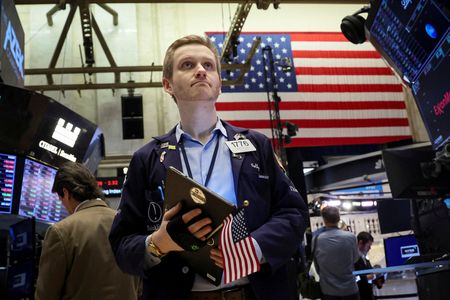
By Chuck Mikolajczak
NEW YORK (Reuters) – The S&P 500 rose more than 1% in choppy trading on Wednesday after a policy announcement by the Federal Reserve that raised interest rates to meet market expectations as the central bank tries to fight rising inflation without tilting the economy into a recession.
The Federal Reserve raised its target interest rate by three-quarters of a percentage point and projected a slowing economy and rising unemployment in the months to come.
Equities alternated between moving higher and paring gains following the announcement, getting their most recent lift after Chair Jerome Powell said in his press conference that either 50 basis points or 75 basis points were most likely at the next meeting in July but that he did not expect hikes of 75 basis points to be common.
“The runway for them to have a soft landing just got shorter and narrower, meaning that they are anticipating higher inflation, they are anticipating higher unemployment, they are anticipating lower GDP … so whether or not we can escape this without a recession is coming into question,” said Ellen Hazen, chief market strategist at F.L.Putnam Investment Management in Wellesley, Massachusetts.
“Everyone knew it, but now the Fed is admitting it.”
The Dow Jones Industrial Average rose 268.26 points, or 0.88%, to 30,633.09, the S&P 500 gained 48.32 points, or 1.29%, to 3,783.8 and the Nasdaq Composite added 241.63 points, or 2.23%, to 11,069.97.
Investors had quickly raised their expectations that the central bank would hike rates by 75 basis points (bps) over the past several days following a stronger than expected reading of consumer prices on Friday. It had previously been widely anticipated the Fed would announce a raise of 50 bps, a rapid swing in expectations that has triggered a violent selloff across world markets.
Fueling the expectation for a larger hike were forecasts changes by analysts at major banks, including those at JP Morgan and Goldman Sachs, which both projected a 75 bps rate hike by the Fed. Investors have since rushed to reprice their bets.
Growing worries about surging inflation, higher borrowing costs, slowing economic growth and corporate earnings have kept equities under pressure for most of the year.
On Monday, the benchmark S&P 500 marked a more than 20% decline from its most recent record closing high, confirming a bear market began on Jan. 3, according to a commonly used definition.
Earlier economic data on Wednesday showed U.S. retail sales unexpectedly fell 0.3% in May as motor vehicle purchases declined amid shortages and record high gasoline prices pulled spending away from other goods, well short of expectations calling for a 0.2% rise.
Among individual stocks, Citigroup rose 3.31% to lead gains on the S&P 500 banks index, while Nucor Corp advanced 1.38% after it forecast upbeat current-quarter profit on strong steel demand.
Boeing Co surged 8.87% after China Southern Airlines Co Ltd conducted test flights with a 737 MAX plane for the first time since March, in a sign the jet’s return in China could be nearing as demand rebounds.
Advancing issues outnumbered declining ones on the NYSE by a 2.66-to-1 ratio; on Nasdaq, a 2.56-to-1 ratio favored advancers.
The S&P 500 posted 1 new 52-week highs and 41 new lows; the Nasdaq Composite recorded 12 new highs and 244 new lows.
(Reporting by Chuck Mikolajczak; Editing by Aurora Ellis)

